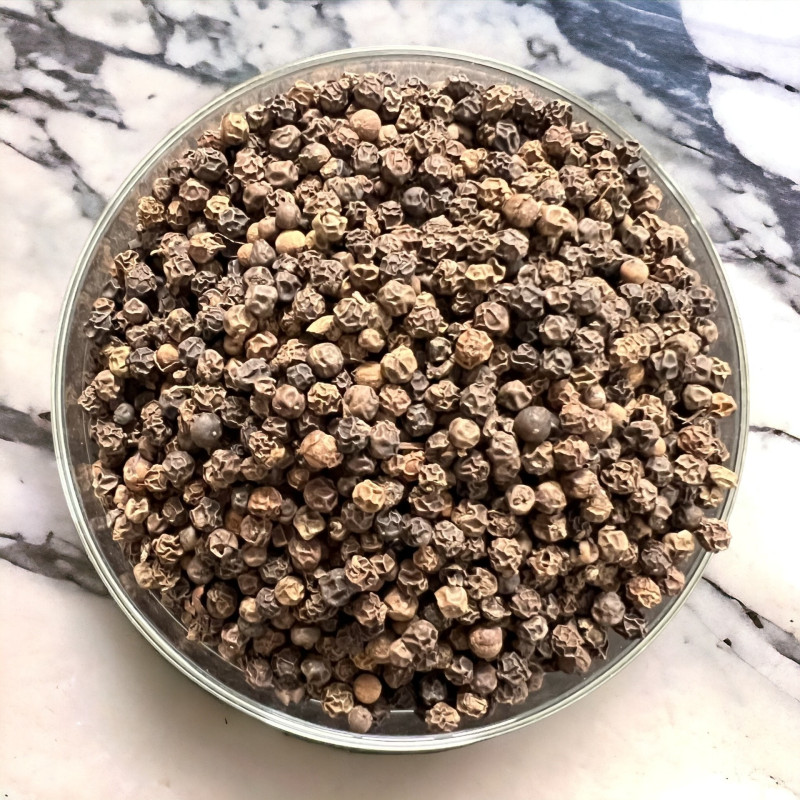
Reference: poivre5baiesE


Originaire d'Inde, le pays d'origine du poivre, son parfum est très fruité, avec une note citronnée. En bouche, il est raisonnablement piquant.
Il est idéal pour relever les viandes, les poissons, les légumes et beaucoup d'autres plats.
 Delivery
Delivery
Mondial Relay
 Returns
Returns
See conditions
 Payments
Payments
100% secure
Livré en sachet refermable
Uses in Cooking:
On the nose, this pepper has a very fruity and slightly lemony aroma. On the palate, it is moderately spicy, with that fruity flavor always present. Its color is medium brown, and its grains are of medium size (about 4 mm in diameter) and are fairly smooth.
This pepper of exceptional origin will happily flavor all your dishes, but particularly meats and fish. It should obviously be passed through a mill or crushed in a mortar.
Who am I?
Origin: Southwest India, Malabar region
Scientific name: Piper nigrum
The Malabar coast, from which this pepper originates, is a stretch of coastline in Southwest India, between the state of Goa to the north and Cape Comorin to the south, primarily forming the shores of the states of Kerala and Karnataka. It is the wettest region in South India. Here you will find cities that still evoke dreams of great journeys: Cochin, Mahé, Cranganore… This region is the origin of all peppers currently planted worldwide, making Malabar pepper the ancestor of all other peppers!
Pepper is a spice that comes from the berries of the pepper plant (a member of the Piperaceae family). There are several varieties found around the world. However, black, white, and green peppers are all from the same fruit of this exotic vine, which only starts to bear fruit after 7 to 8 years.
Piper nigrum produces in order, according to the maturity of its fruits:
Green Pepper: This is picked first, long before maturity. It is preserved in brine or dried. It is strong and pungent, similar to black pepper, as each retains its skin.
Black Pepper: This is picked when slightly more mature but still before full ripeness. Drying turns it black and wrinkles its skin. It is this skin that gives it its strength and pungency. It is the most widely used pepper in the world and is known to pair with almost all spices.
White Pepper: Finally, this consists of fully ripe berries that are soaked to remove their skins and then dried until they turn white. It is considered to be less pungent than black pepper and has a finer taste. What is certain is that it differs from black pepper, regardless of the pepper's origin, and has the advantage of not leaving black specks in white sauces.
While the cultivation of pepper began in Malabar, it has since spread worldwide: Southeast Asia (Indonesia and Malaysia), Madagascar, and Brazil. Recently, Vietnam has become the largest global producer of pepper. There are as many different flavors of pepper as there are places where it is cultivated, somewhat like wine!
Only the fruits of Piper nigrum (the traditional black, white, and green peppers), Piper cubeba (cubeb pepper), and Piper longum (long pepper) are legally allowed to be called "pepper."
Pepper owes its spicy flavor to amides of piperine.
A Little History:
In Greece, under Alexander the Great, pepper was already in use, as it was among the Romans in antiquity.
Due to their high price, pepper and other rare spices were used as currency after the Arab conquest of Alexandria in 642 CE. This is where the expression "to pay in cash" (derived from "spices") comes from. Prices were such at the time that a person's wealth was assessed based on the amount of pepper they owned…!
The exorbitant price of pepper in the Middle Ages and the monopoly on its trade held by Italy were among the reasons that motivated the Portuguese to find a sea route to India. After Vasco da Gama discovered this route in 1498, a treaty was signed granting the Portuguese exclusive rights to half the world, including the origin of black pepper. A century later, they lost this monopoly to the Dutch (with their East India Company) and the English.
It was during the Renaissance, with the development of trade, that the price of pepper began to decrease.
Data sheet
Specific References
Reference: poivre5baiesE
Reference: 6N745801
Reference: poivrevoatsE
Reference: pimentjamaiqueE
Reference: 6N745801
Reference: Kubebe
Reference: poivreNEmada
Reference: poivreEbiosaotome
Reference: poivrevoatsE
Reference: baieroseE
Reference: 2M6273801
Reference: 1N7049301
Reference: 9N7644901
Reference: poivreBEviet
Reference: SriLankaBlanc
Reference: poivresichuanV

Originaire d'Inde, le pays d'origine du poivre, son parfum est très fruité, avec une note citronnée. En bouche, il est raisonnablement piquant.
Il est idéal pour relever les viandes, les poissons, les légumes et beaucoup d'autres plats.